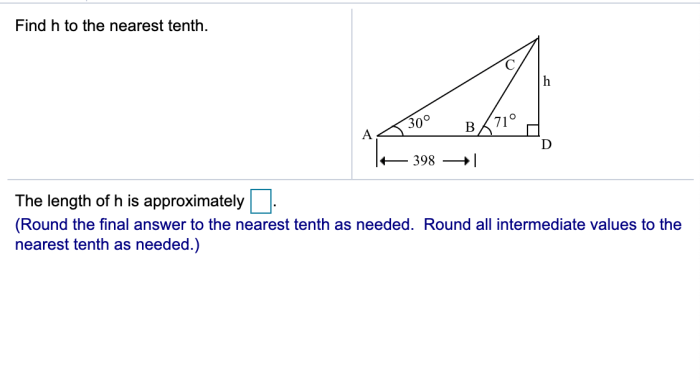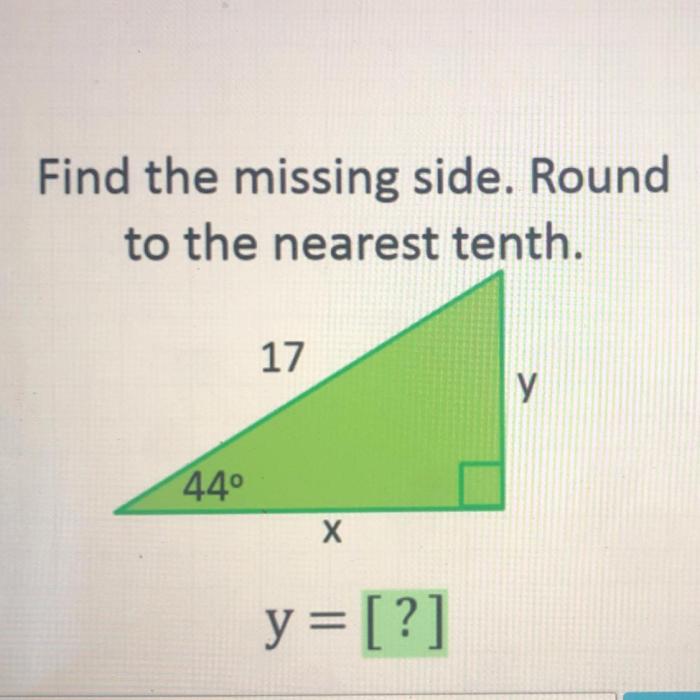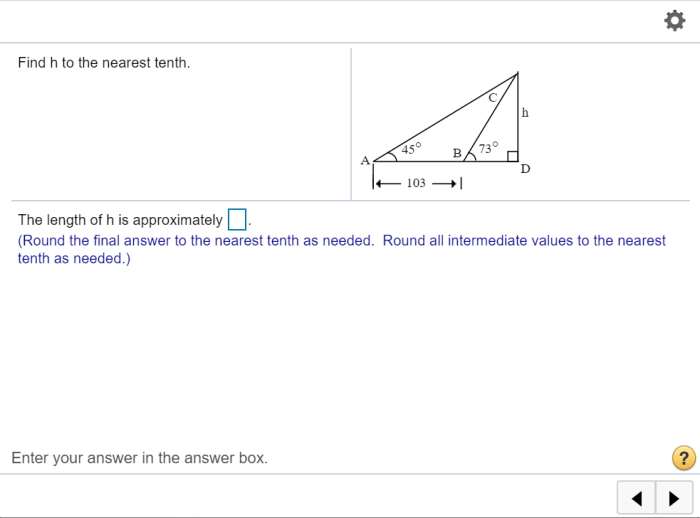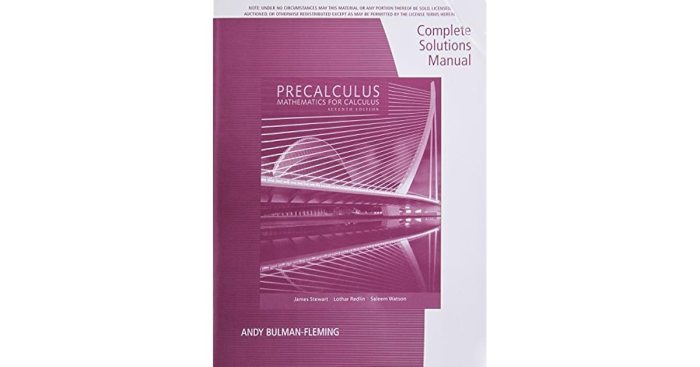Find h to the nearest tenth is an essential mathematical concept that involves rounding a number to the nearest tenth place. It finds applications in various fields, including measurement, estimation, and data analysis. This guide will delve into the intricacies of finding h to the nearest tenth, exploring its methods, applications, and significance.
Understanding the concept of rounding and its implications is crucial for accurate calculations and precise measurements. This guide will provide a comprehensive overview of finding h to the nearest tenth, equipping readers with the knowledge and skills to tackle real-world problems.
Define “find h to the nearest tenth”

Finding h to the nearest tenth means determining the value of h rounded to the nearest tenth place. The tenth place is the first digit after the decimal point.
Rounding to the Nearest Tenth
To round a number to the nearest tenth, follow these steps:
- Look at the digit in the hundredth place (the second digit after the decimal point).
- If the digit is 5 or greater, round up the digit in the tenth place by one.
- If the digit is less than 5, leave the digit in the tenth place as it is.
Example:
Figuring out how to find h to the nearest tenth can be a bit tricky. If you’re struggling, check out the unit 9 progress check mcq . It’s got some helpful tips that can make the process a lot easier.
Once you’ve got the hang of it, finding h to the nearest tenth will be a piece of cake!
- Round 1.234 to the nearest tenth: Since the hundredth place digit (4) is less than 5, we leave the tenth place digit (2) as it is. Therefore, 1.234 rounded to the nearest tenth is 1.2.
- Round 1.567 to the nearest tenth: Since the hundredth place digit (7) is greater than or equal to 5, we round up the tenth place digit (5) by one. Therefore, 1.567 rounded to the nearest tenth is 1.6.
Methods for Finding h to the Nearest Tenth: Find H To The Nearest Tenth

Determining h to the nearest tenth involves rounding the value to the nearest tenth place. Several methods can be employed to achieve this, each with its advantages and drawbacks.
Traditional Method: Rounding Using Place Value
The traditional method of rounding to the nearest tenth utilizes place value. It involves examining the digit in the hundredths place. If this digit is 5 or greater, the tenths digit is increased by 1. If the digit is less than 5, the tenths digit remains unchanged.
For instance, to round 0.125 to the nearest tenth, the hundredths digit (5) is greater than 5, so the tenths digit (1) is increased by 1, resulting in 0.2.
Alternative Method: Number Line
An alternative method for finding h to the nearest tenth is using a number line. Mark the value of h on the number line and identify the two tenths that it lies between. The tenth closest to h is the rounded value.
For example, to find h to the nearest tenth for 0.125, mark 0.125 on the number line. It lies between 0.1 and 0.2, with 0.1 being closer. Therefore, h rounded to the nearest tenth is 0.1.
Alternative Method: Estimation
Estimation can also be used to find h to the nearest tenth. This method involves approximating the value of h to the nearest tenth based on its magnitude. For instance, if h is approximately 0.15, it can be rounded to 0.1. If h is approximately 0.27, it can be rounded to 0.3. Estimation is less precise than the traditional method or using a number line but can be useful for quick approximations.
Comparison of Methods, Find h to the nearest tenth
The traditional method of rounding using place value is the most accurate and widely used. It provides the exact rounded value to the nearest tenth. Using a number line is also accurate but may be less efficient for large numbers.
Estimation is the least accurate method but can be useful for quick approximations. The choice of method depends on the desired level of accuracy and the specific application.
Applications of Finding h to the Nearest Tenth

Finding h to the nearest tenth has practical applications in various fields, including:
- Construction:Calculating the height of buildings, bridges, and other structures requires accurate measurements of h. Rounding to the nearest tenth ensures consistency and facilitates calculations for construction plans and material estimates.
- Surveying:Determining the elevation of landforms and mapping out terrain involves finding h to the nearest tenth. This precision allows for accurate contour lines and measurements of slopes and gradients.
- Engineering:Designing and building machines, vehicles, and other mechanical systems requires precise measurements of heights and clearances. Rounding to the nearest tenth helps ensure proper fit and functionality.
Precision and accuracy are crucial in these applications, as even slight variations in h can impact the safety, stability, and performance of structures and systems.
Rounding and Calculations
Rounding h to the nearest tenth affects calculations and measurements. For example, if the actual height of a building is 125.4 meters, rounding it to 125.0 meters introduces a difference of 0.4 meters. While this may seem insignificant, it can accumulate over multiple calculations and lead to larger discrepancies.In
applications where precision is paramount, such as engineering or scientific research, it is important to consider the impact of rounding and use appropriate techniques to minimize errors.
Examples and Practice

To reinforce our understanding of finding h to the nearest tenth, let’s explore some practical examples and practice exercises.
Numerical Examples
Example 1:Find h to the nearest tenth for the triangle with base b = 15.2 cm and area A = 67.6 cm 2.
h = (2
- A) / b = (2
- 67.6 cm2) / 15.2 cm = 8.9 cm
Example 2:A rectangular prism has a base area of 12.5 cm 2and a volume of 50 cm 3. Find the height h of the prism to the nearest tenth.
h = V / A = 50 cm3/ 12.5 cm 2= 4 cm
Practice Problems
1. Find the height h of a triangle with a base of 18.4 cm and an area of 92 cm 2.
2. A rectangular prism has a base area of 15.6 cm 2and a volume of 78 cm 3. Find the height of the prism.
Interactive Exercise
To enhance your understanding, try this interactive exercise:
| Base (cm) | Area (cm2) | Height (cm) |
|---|---|---|
Detailed FAQs
What is the traditional method of finding h to the nearest tenth?
The traditional method involves examining the digit in the hundredths place. If it is 5 or greater, the digit in the tenths place is increased by one. If it is less than 5, the digit in the tenths place remains the same.
What are some alternative methods for finding h to the nearest tenth?
Alternative methods include using a number line or estimation. A number line provides a visual representation of numbers, making it easier to estimate the nearest tenth. Estimation involves approximating the value of h based on its proximity to nearby whole numbers.
How is finding h to the nearest tenth used in real-world applications?
Finding h to the nearest tenth is used in various real-world applications, such as measuring lengths, calculating averages, and estimating quantities. It ensures accuracy and precision in measurements and calculations, leading to reliable results.


